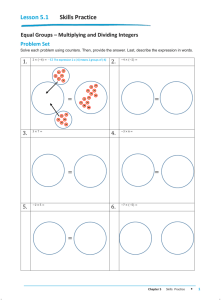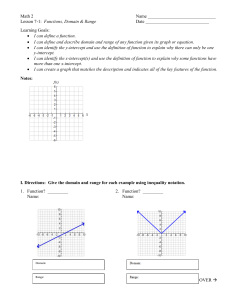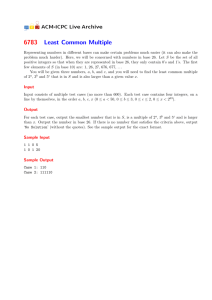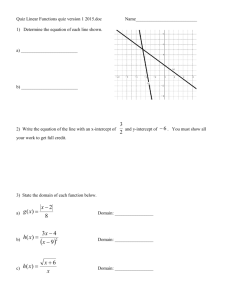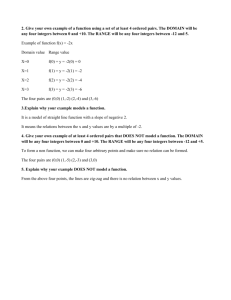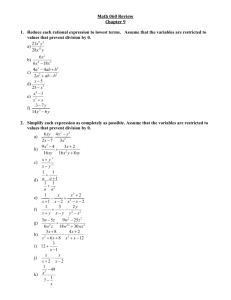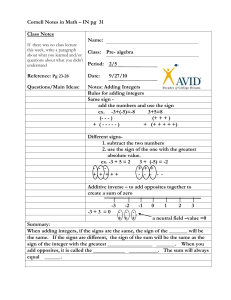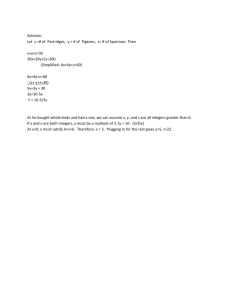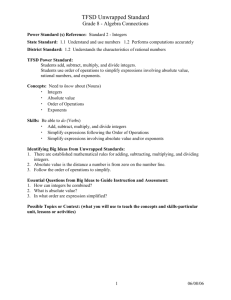Additional Support for Math 99 Students
advertisement
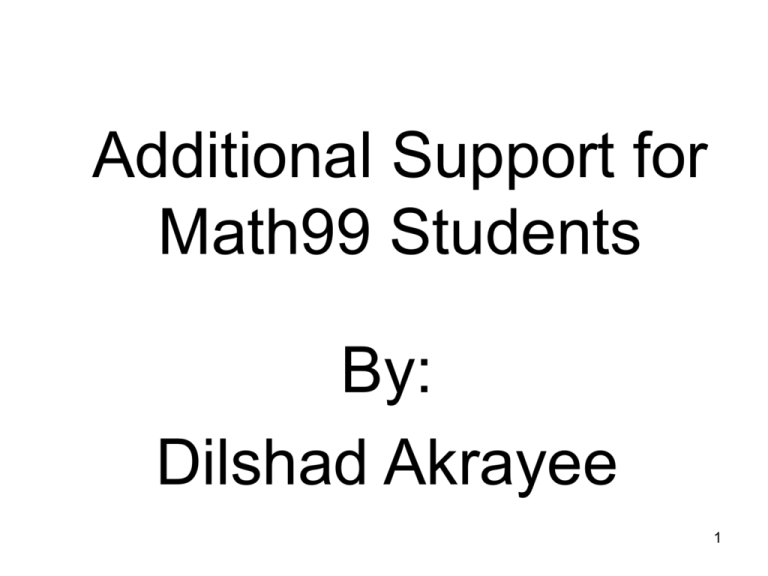
Additional Support for
Math99 Students
By:
Dilshad Akrayee
1
Summary
Distributive
a*(b + c) = a*b + a*c
3(X+Y)= 3x+3Y
2( 3 5 ) 2 3 2 5
2
Example
x x x
2
3
4
3
1
3
2
x x
3
Multiplication of Real Numbers
(+)(+) = (+) •
When something good happens to
somebody good… that’s good.
(+)(-) = (-)
• When something good happens to
somebody bad ...that’s bad.
(-)(+) = (-)
• When something bad happens to
somebody good ...that’s bad.
(-)(-) = (+)
• When something bad happens to
somebody bad ...that’s good.
4
Examples
+6
-6
+7
-5
X
X
X
X
+9
-8
-8
+7
+54
= +48
= -56
= -35
=
5
Multiplying Fractions
If a, b, c, and d are real numbers then
a * c a *c
b d b*d
EX)
2 * 4 2*4 8
3 5 3 * 5 15
6
Division with Fractions
If a,b,c,and d are real numbers. b,c,
and d are not equal to zero then
c
a
d
a *
b d b c
7
Example Divide
2 5 2 7 14
*
3 7 3 5 15
8
Rule
If a,b,c,and d are real numbers. b
and d are not equal to zero then
a c a *d b*c
b d
1 5 1*10 2 * 5
2 10
9
Ex) simplify
| 4 7 | | 3 | 3
1
3
3
47
10
Real Number System
{1, 2, 3, 4,…}
Natural #
=
Whole #
= {0,1, 2, 3, 4,…}
= {…-3,-2,-1,0,1, 2, 3,…}
Integers #
Natural #
Whole #
Integers #
11
Write the prime factorization of
24
2
24
2
12
2
6
3
3
1
242
3
*3
12
Addition of Fractions
• If a, b, and c are integers and c
is not equal to 0, then
a b ab
c c
c
13
Example: Simplify the following
1
2
1
3
2
5 5
5
5
14
Subtraction of Fractions
• If a, b, and c are integers and c
is not equal to 0, then
a b a b
c c
c
15
Write the prime factorization of
24
2
24
2
12
2
6
3
3
1
242
3
*3
16
Definition LCD
The least common
denominator (LCD) for a set of
denominators is the smallest
number that is exactly divisible
by each denominator
Sometimes called the least
common multiple
17
Find the LCD of 12 and 18
12 = (2)(2)(3)
18 = (2)(3)(3)
• The LCD will contain each factor
the most number of times it was
used.
(2)(2)(3)(3) = 36
• So the LCD of 12 and 18 is 36.
18
Note
For any algebraic expressions A,B, X,
and Y. A,B,X,Y do not equal zero
A X
B Y
AY BX
19
Example
1 5
2 10
1*10 2 * 5
10
=
10
20
Using the Means-Extremes Property
• If you know three parts of a proportion
you can find the fourth
3 x
20
4
X = 15
3 * 20 = 4 * x
60
= 4x
60 = 4x
4
4
21
Chart
of
Multiply •
is
equals =
A number
x
22
Chart
4 more than x
4 times x
4 less than x
x+4
4x
x–4
23
Chart
At most it means less or equal which is
<
At least it means greater or equal which is>
24
Term
Example Variable Using
Consecutive Integers 4,5,6,7 X, X+1, X+2, X+3
Consecutive Even Integers 2,4,6,8 X, X+2, X+4, X+6
Consecutive Odd Integers 3,5,7,9 X, X+2, X+4, X+6
25
Ex)The sum of two consecutive
integers is 15. Find the numbers
Let X and X+1 represent the two numbers.
Then the equation is:
X + X + 1 = 15
2X + 1 = 15
2X = 15 -1
2X = 14
X=7
X+1 = 7 +1 = 8
26
Ex)The sum of two consecutive odd
integers is 28. Find the numbers
Let X and X+2 represent the two numbers.
Then the equation is:
X + X + 2 = 28
2X + 2 = 28
2X = 28 -2
2X = 26
X = 13
X+2 = 13 +2 = 15
27
Ex)The sum of two consecutive even
integers is 106. Find the numbers
Let X and X+2 represent the two numbers.
Then the equation is:
X + X + 2 = 106
2X + 2 = 106
2X = 106 -2
2X = 104
X = 52
X+2 = 52 +2 = 54
28
Definition - Intercepts
The x-intercept of a
straight line is the xcoordinate of the point where
the graph crosses the x-axis
The y-intercept of a
straight line is the
y-coordinate of the point where
the graph crosses the y-axis.
y-intercept
x-intercept
29
Ex) Find the x-intercept and the yintercept of 3x – 2y = 6 and graph.
• The x-intercept
occurs when y = 0
( 2 , 0)
• The y-intercept
occurs when x = 0
(0, -3 )
30
EX) Find the x-and y-intercepts for
To find x-intercept,
let y=0
2x+0 = 2
x=1 x-intercept (1, 0)
To find y-intercept,
let x=0
2(0)+y = 2
y=2
y-intercept (0, 2)
2x +y= 2
(0, 2)
(1, 0)
31
Ex) Find the x-intercept and the
y-intercept: 3x-y=6
The answer should be
X-intercept
(2, 0)
Y-Intercept
(0, -6)
32
Find the slope between
(-3, 6) and (5, 2)
( y2 ) ( y1 )
m
( x2 ) ( x1 )
y2
x1
y1
x2
4
(2) (6)
1
m
(5) (3)
8
2
33
Exponent Summary Review
a a a
r
s
r
rs
a
r s
a
s
a
Properties
a a
r s
ab
r
r s
r
r
a b
r
a
a
r
b b
r
34
Exponents’ Properties
1) If a is any real number and
r and s are integers then
a
r
*
a
s
=
a
r s
To multiply with the same
base, add exponents and
use the common base
35
Examples of Property 1
x x
3
2
x
3 2
x
5
36
Exponents’ Properties
2) If a is any real number and r and
s are integers, then
a
s
r
a
r s
A power raised to another power
is the base raised to the product
of the powers.
37
Example of Property 2
x
3
2
x
6
One base, two exponents…
multiply the exponents.
38
Exponents’ Properties
3) If a and b are any real number and r is an
integer, then
ab
r
a b
r
r
Distribute the
exponent.
39
Examples of Property 3
5x
2
5 x 25x
2
2
2
40
EX) Complete the following
X
2
3
(2)
x
2
4
9
4
3
x
x
8
27
8
16
4
81
16
41
Exponents’ Properties
4) If a is any real number and
r and s are integers then
a
a
r
s
=
a
r s
(a 0)
To divide with the same
base, subtract exponents and
use the common base
42
Example
3
a
=
2
a
a
3-2
a a
1
43
EX) Complete the following table
A B
4
2
A* B
6
A
B
2
x
x
x
x
3
12 x 2 x 24 x 6 x
4
2x 2x 4x x
5
6
8
10
2
2
44
Exponent Summary Review
Definitions
a
1
r
a
r
a0
a a
1
a 1
0
a0
45
Examples of Foil
A) (m + 4)(m - 3)=
m2 + m - 12
B) (y + 7)(y + 2)=
y2 + 9y + 14
C) (r - 8)(r - 5)=
r2 - 13r + 40
46
Finding the Greatest Common
Factor for Numbers
• Write each number in
prime factored form.
• Use each factor the
least number of times
that it occurs in all of the
prime factored forms.
• Usually multiply for final
answer.
• Find GCF of 36 and 48
36 = 2 ·2 ·3 ·3
48 = 2 ·2 ·2 ·2 ·3
2 occurs twice in 36 and
four times in 48
3 occurs twice in 36 and
once in 48.
GCF = 2 ·2 ·3
=12
47
Find the GCF of 30, 20, 15
30 = 2 · 3 · 5 Since 5 is the only
common factor it is
20 = 2 · 2 · 5
also the greatest
15 = 3 · 5
common factor GCF.
48
Find the GCF of 6m4, 9m2, 12m5
6m4 = 2 · 3 · m2 · m2
9m2 = 3 · 3 · m2
12m5 = 2 · 2 · 3 · m2 · m3
GCF =
2
3m
49
Factor
x 15 x 56 ( x 7)( x 8)
2
First list the factors of 56.
Now add the factors.
1 56 57
2 28 30
4 19 23
7 8 15
Check with Multiplication.
x 7 x 8x 56
2
( x 7 x) (8x 56)
x( x 7) 8( x 7)
( x 7)( x 8)
2
50
Notice that 7 and 8 sum to the middle term.
Factor
x 14 x 24 ( x 2)( x 12)
2
First list the factors of 24.
Now add the factors.
1 24 25
2 12 14
3 8 11
4 6 10
Check with Multiplication.
x 2 x 12 x 24
2
( x 2 x) (12 x 24)
x( x 2) 12( x 2)
( x 2)( x 12)
2
51
Notice that 2 and 12 sum to the middle term.
Zero-Factor Property
If a and b are real numbers
and if ab =0, then
a = 0 or
b = 0.
52
Ex) Solve the equation (x + 2)(2x - 1)=0
By the zero factor property we know...
Since the product is equal to zero then one
of the factors must be zero.
( x 2) 0
x 2
OR (2 x 1) 0
2x 1
2x 1
2 2
1
x
1
2
the solution is x {2, }
2
53
Solve.
x 9 x 18
2
x 9 x 18 0
2
( x 6)( x 3) 0
x {6, 3}
54
Fun Facts About Opposites
• Each negative number is the opposite of
some positive number.
• Each positive number is the opposite of
some negative number.
-(-a) = a
• When you add any two opposites the
result is always zero.
a + (-a) = 0
55
Absolute Value Example
|5 – 7| – |3 – 8|
= |-2| – |-5|
=2–5
= -3
56
Definition:
Two numbers whose product is 1
are called reciprocals
a
For example: the reciprocals of
b
is b
a
57
Example Simplify
3
2x
2
y
4x
5
y
3
5
2
x y
2x y
2
y 4x
2
3
58
Memorize the First 10 Perfect Cubes
n
1
2
3
4
5
6
7
8
9
10
n2
1
4
9
16
25
36
49
64
81
100
n3
1
8
27
64
125
216
343
512
729
1000
59
What is the Root?
64 8
8 8 64
3
64 4
4 4 4 64
6
64 2
2 2 2 2 2 2 64
60
Examples
16 4i
81 9i
7 i 7
61
If you square a radical you get
the radicand
5
2
5
Whenever you have
i2 the next turn you
will have -1 and no
i.
i
2
2
1
i 1
2
62
First distribute the
negative sign.
Subtract
Now collect like
terms.
(5 7i) (4 20i)
5 7i 4 20i
9 13i
63
Powers of
i
1 i raised to the 0 is 1.
1 Anything raised to the 1 is itself.
i i
2
2
i 1
1 i
3
3
2
i i i i i (1)i i
0 Anything other than 0
64
The Quadratic Formula
The Quadratic Theorem:
For any quadratic equation in the form
ax bx c 0
2
where a 0 the two solutions are :
b b 4ac
x
2a
2
and
b b 4ac
x
2a 65
2
Ex) Use the quadratic formula to
solve the following:
3x 6 x 2 0
2
3 3
The answer is x
3
66
Ex. Solve. x2 = 64
x 64
2
x 64
x 8
x {8, 8}
Take the square root of
both sides.
2
Do not forget the ±.
The solution set has
two answers.
67
Identify the Vertex
y = a(x - a)2 + b
(a, b)
y = -3(x - 3)2 + 48
(3, 48)
y = 5(x + 16)2 - 1
(-16, -1)
68
